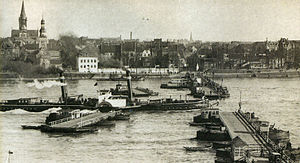Mülheim ship bridge
Coordinates: 50 ° 57 ′ 45 ″ N , 6 ° 59 ′ 41 ″ E
| Mülheim ship bridge | ||
|---|---|---|
| Opened Mülheim ship bridge at the end of the 19th century | ||
| Convicted | Road traffic | |
| Subjugated | Rhine | |
| place | Mülheim am Rhein , Cologne | |
| construction | Floating bridge with swimmable yokes | |
| width | 12 m | |
| building-costs | 185,000 marks | |
| opening | May 29, 1888 | |
| closure | June 20, 1927 (demolition) | |
| toll | 4 pfennigs | |
| location | ||
|
|
||
The Mülheim ship bridge was a wooden bridge construction that floated on about 40 pontoons anchored in the Rhine . It replaced a ferry connection that had previously operated between Mülheim am Rhein and the Mülheimer Häuschen belonging to Longerich at the same point . The new Rhine crossing was opened to traffic in 1888.
history
A slightly elevated, flood- protected bank location of Mülheim am Rheinstrom, north of the confluence of the Strunde (Strunder Bach) and about 200 meters south of today's Mülheimer Bridge , caused all roads in the surrounding area to converge here in medieval times. The sovereign Count Adolf built the first fortification here in 1265 , and in 1268 the Cistercian monks of the Altenberg monastery acquired the right to operate the first ferry connection to the coast of the Electorate of Cologne . In addition to the income obtained from the ferry service through this privilege , the friars were now able to better reach their farm estate , which is located in Johannisstrasse in the northern suburb of Niederich . Around 1700 they returned their rights to the Mülheim ferry service to Haus Berg .
Rhine crossings
This was followed by a ferry service from Haus Berg around 1700 for an annual lease of 400 Reichstalers , which was carried out with a so-called flying Rhine bridge or Gierponte that uses the current . It was a floating platform that could be set at an angle to the current with the help of ropes , so that it could commute between the banks, driven by the current. This type of crossing ended in 1844 and was replaced by ferry boats by 1872, which now took over the transport of people and goods in both directions. In 1868 Mülheim itself took over the Rhine ferry on lease and replaced the previous technology from 1872 with a cable ferry that operated until 1887. These boats are said to have been the origin of the later common term Mülheimer Böötche .
Buying a bridge
On May 7, 1885, the city of Mülheim acquired a used ship's bridge from Mainz at a price of 45,000 marks; the transport costs to the planned new location amounted to a further 120,000 marks. It was laid out in Mülheim on Buchheimer Strasse, which led to Wiener Platz . Extensive power expansion measures, work to anchor the individual elements as well as the permanent dredging of a fairway in the Rhine at the point of the bridge segment to be opened for the passing ship traffic cost another 85,000 marks, so that the total investment amounts to 185,000 marks (adjusted for inflation, corresponds to a current equivalent of 1 , 4 million euros ). The bridge was put into operation on May 29, 1888. The bridge was opened to shipping traffic at set times. For the use of the 12 meter wide bridge, on which smoking was prohibited under threat of fire because of the risk of fire, 4 pfennigs had to be paid. Already on the first day of operation, it is severely damaged when a ship passes through it.
The ship bridge, which was operated by the city of Mülheim until 1912, was then taken over by the leaseholder Richard Majewski, who maintained operation until the permanent bridge over the Rhine between the districts of Mülheim and Riehl was completed . From July 1, 1912, Majewski levied bridge and travel fees from users, but fell behind with his lease payments to the city of Mülheim. When Majewski was called up during the First World War , he had his lawyer terminate the lease on March 31, 1915.
End of the ship bridge
The decrepit bridge was no longer able to cope with the increasing traffic in the beginning of the 20th century and often failed when there was ice or flooding. In order to achieve a more reliable connection between the northern and northeastern districts of Cologne and at the same time to increase the bridge capacity, an alternative was considered. During the incorporation negotiations with Mülheim in 1913, Cologne committed to building a permanent bridge.
On June 20, 1927, the old ship bridge was closed and dismantled. In October 1929, the new Mülheim suspension bridge, which was then the largest suspension bridge in the world, was put into operation.
literature
- Joachim Deeters: in sources on the history of the city of Cologne , Volume II. Late Middle Ages and early modern times. Friends of History in Cologne V., JP Bachem Verlag Cologne, ISBN 3-7616-1285-0
- Carl Dietmar: Die Chronik Kölns , Chronik Verlag, Dortmund 1991, ISBN 3-611-00193-7
Individual evidence
- ^ Joachim Deeters: in sources on the history of the city of Cologne
- ↑ Peter Fuchs (ed.), Chronik zur Geschichte der Stadt Köln , 1991, p. 159
- ↑ a b Carl Dietmar, pp. 273, 369
- ^ Online Archive NRW, H. Signon, Bridges in Cologne on the Rhine, Cologne 1966. Buildings in Cologne 1928–1988, Cologne 1991. Archived copy ( memento of the original from November 7, 2017 in the Internet Archive ) Info: The archive link was inserted automatically and not yet checked. Please check the original and archive link according to the instructions and then remove this notice.


